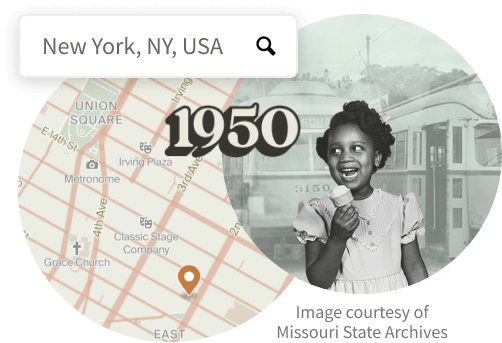Source Information
Population Schedules for the 1950 Census, 1950 - 1950. NAID: 43290879. Records of the Bureau of the Census, 1790 - 2007, Record Group 29. National Archives at Washington, DC., Washington, DC.
About 1950 United States Federal Census
About the 1950 United States Federal Census
General collection information
A U.S. census record is only available to the general public 72 years after Census Day. This census may help you discover more about how the Great Depression, World War II, and the start of the Baby Boom affected your family.
Thanks to our proprietary handwriting recognition technology, all 1950 U.S. Census records are now searchable. Transcription accuracy is dependent upon the quality of the document being scanned. For best results, view the census image.
Using this collection
Using this collection, you can find out a lot about someone in 1950.
While not everyone was asked the supplemental questions, details about your family may include the following:
The census is organized alphabetically by state, county, and enumeration district, which is the area covered by a census taker. City enumeration districts tend to be small and dense, while rural districts are usually bigger with sparser populations. Once you find someone in the census, you can explore their enumeration district, city directories, and telephone books to learn more about their community and how they lived.
Specific collection details
The 1950 U.S. Census includes never-before-seen genealogical information, including enumeration district maps, population schedules, Indian reservation schedules, and more.
Most enumeration districts could be recorded in less than 70 pages, but standard procedure dictated that pages were numbered 1 through 70. It wasn't unusual for an enumeration district to end before page 70, leaving blank pages, and then pick up again on page 71 if there were supplementary records.
Census information generally wasn't retained for military personnel living abroad. However, there are records for servicemembers who were stationed in the American territories of Alaska, Hawaii, American Samoa, Guam, Panama Canal Zone, Puerto Rico, the U.S. Virgin Islands and the military bases of Canton [Kanton], Johnston, Midway, and Wake Island. There are also records for servicemembers who lived in barracks on U.S. soil; they were counted as living separately from their families.
College students who lived on campus weren't listed with their families because they were enumerated in their dorms.
Native Americans living on reservations were listed on additional forms known as Indian reservation schedules. Native Americans living off-reservation, or on reservations in Alaska and Oklahoma, were listed on standard population schedules.
While infants born before April 1, 1950 will appear on population schedules, there was initially more information about them on "Infant Cards," but those were later removed and no longer exist.
Housing schedules detailing information about residents' physical homes were recorded on the reverse sides of population schedule forms, but they weren't microfilmed and no longer exist.
Collection in context
The 1950 U.S. Census saw the use of many modern innovations, creating a more accurate and detailed report than ever before. This was quite a feat, considering the census began on April 1, 1950 and lasted just four weeks. This census was the first to include Americans living abroad and special studies were included to record information on infants, Native Americans, agriculture, and housing. In 1951, the Census Bureau received the UNIVAC I computer, the first commercial non-military computer, and used it to tabulate the census.
Extra efforts were made to ensure every American was counted. Census takers received additional training, including visiting hotels to catch people not at home, "missed person" forms were printed in local newspapers, and sample locations were recounted and compared to the original tabulation. While the 1950 U.S. Census saw great advances in collection techniques, it is estimated that 4.1% of the population was missed.
Bibliography
Ferriero, David. "Preparing for the 1950 Census." AOTUS Blogs. Last modified March 24, 2021. https://aotus.blogs.archives.gov/2021/03/24/preparing-for-the-1950-census/.
Kluskens, Claire. "1950 Census: Infant Cards and the Special Infant Enumeration Study." History Hub. Last modified April 19, 2021. https://historyhub.history.gov/community/genealogy/census-records/blog/2021/04/19/1950-census-infant-cards-and-the-special-infant-enumeration-study.
Macchi, Victoria. "1950 Census Release Will Offer Enhanced Digital Access, Public Collaboration Opportunity." National Archives News. Last modified December 14, 2021. https://www.archives.gov/news/articles/1950-census-access. .
The United States Census Bureau. “1950 Overview." Last modified December 9, 2021. https://www.census.gov/history/www/through_the_decades/overview/1950.html.
